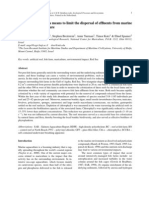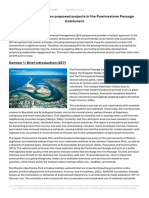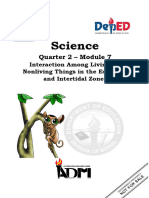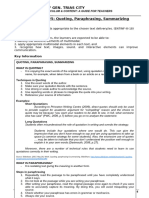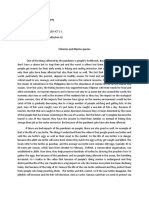P C & M R: A I: Hilippines Oastal Arine Esources N Ntroduction
P C & M R: A I: Hilippines Oastal Arine Esources N Ntroduction
Uploaded by
Goran SapiandanteCopyright:
Available Formats
P C & M R: A I: Hilippines Oastal Arine Esources N Ntroduction
P C & M R: A I: Hilippines Oastal Arine Esources N Ntroduction
Uploaded by
Goran SapiandanteOriginal Description:
Original Title
Copyright
Available Formats
Share this document
Did you find this document useful?
Is this content inappropriate?
Copyright:
Available Formats
P C & M R: A I: Hilippines Oastal Arine Esources N Ntroduction
P C & M R: A I: Hilippines Oastal Arine Esources N Ntroduction
Uploaded by
Goran SapiandanteCopyright:
Available Formats
1.
Philippines Coastal & Marine Resources: An Introduction
Thousands of islands. With its thousands of. diversity of marine life. Factors that contribute to
islands, the Philippines has one of the longest this exceptional range of biodiversity include:
coastlines in the world—estimated at 36,289 • A warm climate and stable water temperatures
kilometers. The coastline extends 2,000 kilometers (rarely below 18° Celcius);
from north to south, with 25 major cities lying. • Abundant sunlight to fuel the photo-synthesis
on the coast. It is estimated that more than 60 process that supports the growth of algae,
percent of the nation’s total population of 87.8 coral, and other organisms;
million (July 2005 estimate) lives in the coastal • Relatively low sediment loads, allowing light
zone. Table 1.1 provides basic data about the to pass deep into the water;
Philippines’ coastal geography and population. • Generally low freshwater inputs that maintain
a salinity level between 30 and 36 parts per
Table 1.1 Philippine Coastal Data. thousand;
Number of islands 7,100 • Currents, clean water, and hard substrates that
Total land area 300,000 km2 provide optimal conditions for corals and
Coastline 36,289 km other aquatic life to thrive (White 2001).
Territorial Sea 679,800 km2
(up to 12 nautical miles)
Territorial waters, incl. EEZ 2.2 million km2
Coastal waters 226,000 km2
Oceanic waters 1.93 million km2
Coastal provinces 64 (out of 79)
Coastal municipalities 822 (out of 1,502)
Total coastal population 64.7 million (2000)
Population density in coastal 227 persons per km2
areas, year 1990
Population density in coastal 286 persons per km2
areas, year 2000
No. of inhabitants per 2,467 persons
kilometer of coastline (2000)
Source: http://www.census.gov.ph. Coral trout is often used as an indicator to monitor the
condition of coral reefs.
The country depends heavily on its rich coastal Photo: Ingvar Bundgaard Jensen.
and marine resources for the many economic,
employment, and biodiversity values and services Importance of coastal ecosystems. The coastal.
they provide. zone is the interface where the land meets the
ocean. The Philippines’ diverse coastal zone
An abundance of species. Philippine waters contain consists of a variety of tropical ecosystems,
some of the world’s richest ecosystems, including sandy beaches, rocky headlands, sand
characterized by extensive coral reefs, sea-grass dunes, coral reefs, mangroves, sea-grass beds,
beds, and dense mangrove forests. Blessed with a wetlands, estuaries, and lagoons (Table 1.2). The
sunny tropical climate, waters enriched with various ecosystems are interconnected, making it
nutrients from the land, and driven by the wind, virtually impossible to alter one feature of the
the country supports an exceptionally high coastal zone without affecting another, either
directly or indirectly (Figure 1.1).
PEMFinal.indb 1 10/08/2006 07:31:42
Figure 1.1 Important Coastal Ecosystems and Habitats.
Source: Maragos et al. 1983.
Table 1.2 Key Coastal Habitats.
Beaches An area of unstable unconsolidated sediments like sand or gravel deposited along the shoreline. Beaches
are subject to erosion (removal of material) and accretion (deposition of material) produced by waves,
wind, and tidal currents.
Coral Simple marine animals that live symbiotically with algae. In the symbiotic relationship, the algae provide
the coral with nutrients, while the coral provide the algae with a structure to live in. Coral animals secrete
calcium carbonate to produce a hard external skeleton.
Coral reef Wave and current resistant calcareous structures formed in situ from the skeletons of corals and other
organisms. They constitute the largest biogenic structures on the planet and support assemblages of living
corals and many other organisms, including fish, mollusks, marine worms, crustaceans, algae, and
sponges.
Estuaries A semi-enclosed coastal area at the mouth of a river where nutrient-rich fresh water meets with salty ocean
water.
Foreshore The intertidal part of a beach or the part of the shorefront lying between the beach head (or upper limit of
wave wash at high tide) and the mean low water mark. The foreshore is legally defined as 40 meters
inland from the mean high tide.
Lagoons A body of seawater that is almost completely cut off from the ocean by a barrier beach or the body of
seawater that is enclosed by an atoll.
Mangroves Tree wetlands located on the coastlines in warm tropical climates.
Sea-grass Areas of salt-tolerant plants that occur in shallow near-shore waters, estuaries, lagoons, and adjacent to
beds coral reefs. They hold sediment in place, support a rich detrital community, and provide food and habitat
for many important near-shore species.
Source: Castro and Huber 1997.
PEMFinal.indb 2 10/08/2006 07:31:44
PhilippineS Environment Monitor 2005
Resources of significant value. Coastal. marine attractions are the most important.
ecosystems are valuable in terms of the goods. tourism destinations. Tourism generates revenue
and services they provide (direct use values);. through a number of different sources such as
the ecological functions, which indirectly. recreational user fees, lodging, transportation,
support economic activity (indirect use values); food, and souvenirs. Tourism also leads to.
and the options for direct or indirect use of. higher employment rates and increased incomes
these ecosystems in the future (option use. for businesses related to the tourism sector.
values). Coastal ecosystems also have non-use
values; for example, individuals derive. Table 1.3 Annual Economic Net Benefits from
satisfaction from the aesthetic value of. Philippine Coral Reefs.
ecosystems and the knowledge that they. Resource Use (Direct and Indirect) Value ($ Million)
will continue to exist for future generations Sustainable fisheries 620
(existence and bequest values). Coastal protection (erosion 326
prevention)
The coastal areas of the Philippines provide a Tourism and recreation 108
continuous supply of goods—fish, oil, gas, Aesthetic/biodiversity value 10
minerals, salt, and construction materials—. (willingness to pay)
and services such as shoreline protection, Total net annual benefits 1,064
sustaining biodiversity, maintaining water quality, Net present value 9,063
transportation, and recreation. Sources: Burke et al. 2002; White and Cruz-Trinidad 1998.
The direct benefits from mangroves have.
been estimated to be more than $600 per hectare
per year in fish production and potential
sustainable wood harvest. The annual direct
benefits in the Philippines from mangroves.
are therefore at least $83 million per year (White
and Cruz-Trinidad 1998).
It has been estimated that coral reefs alone
contribute at least $1.064 billion annually to.
the economy (see Table 1.3).
Locally, 1 square kilometer of healthy coral.
A growing tourism industry catering to scuba divers is
reef with some tourism potential produces net providing much needed revenue to local communities.
revenues ranging from $29,000 to $113,000. Photo: Ingvar Bundgaard Jensen.
(White and Trinidad 1998; White et. al. 2000).
These revenue potentials are realistic, since a.
large proportion of visitors to the Philippines In 2004, 2.3 million tourists generated $1.9 billion
spend time on a beach or swim or dive in a coral in tourist receipts (Department of Tourism 2004).
reef environment. This is a 20 percent increase over the volume of
arrivals recorded in 2003. Visitor receipts in 2004
Tourism is a major source of income and also gained a double-digit growth at 30.7
employment for the Philippines. Coastal and percent.
PEMFinal.indb 3 10/08/2006 07:31:46
fisheries (excluding reef fish) were estimated to
yield production values of $741 million in 2003.
The industry employs also more than 1 million
people (5 percent of the national labor force),.
with 68 percent employed in the municipal sector
and 28 percent in the commercial and aquaculture
sectors (ADB 2003).
The Philippines also accounts for 43 percent of.
the marine aquarium fish and 36 percent of the
invertebrates traded globally (Global Marine
Aquarium Database 2003). Box 1.1 describes the
Tourists receive a welcome drink upon arrival to a marine aquarium fishery and trade in the
community-based ecotourism destination.
Philippines.
Photo: Coastal Resource Management Project.
Finally, the hunting and collection of eggs.
An estimated 6.2 million people were employed from marine turtles are also important sources.
in tourism-related businesses in 1998. of income for many coastal communities. But
marine turtles may have an even higher monetary
The Philippines is among the largest fish. value when kept alive (Box 1.2).
producers in the world. The commercial,.
municipal and aquaculture fisheries account. Other ecosystem services. Other values from
for 36, 30 and 24 percent of the total annual marine and coastal resources in the Philippines
fisheries yield, respectively. Its annual total include the huge potential source of wave.
fisheries yield is estimated to be worth around. energy from the ocean (Box 1.3) and the
$70 to 110 billion PhP, equivalent to about 2 to. environmental waste disposal services that marine
4 percent of its gross domestic product over the waters offer (Box 1.4).
years (Barut et al. 1997 and Table 2.1). Municipal
Box 1.1 Marine Aquarium Fishery and Trade.
The collection and trade of marine ornamentals is present in about 100 of the approximately 800 coastal
municipalities in the Philippines, and in 38 (out of 80) of its provinces. With a total value of $7.3 million (2004),
the trade supports the livelihoods of 4,000 to 7,000 households of part time and full time collectors and local
traders of marine ornamentals. There are approximately 70 exporters of marine ornamentals, mostly based in
Manila with some located in Cebu.
While the marine aquarium industry provides livelihoods to a significant number of households, the prevalent use
of destructive collection methods—such as using cyanide and breaking of corals—and overfishing, caused by
high mortality and poor husbandry, contribute to the deterioration of the Philippine coastal ecosystems. The
Marine Aquarium Council addresses these problems by setting standards for best practices in the trade and
assessing compliance to these standards through a third party certification system.
Source: The Marine Aquarium Council, www.aquariumcouncil.org.
PEMFinal.indb 4 10/08/2006 07:31:48
PhilippineS Environment Monitor 2005
Box 1.2 Marine Turtles: Worth More Alive Than Dead.
The monetary value of marine turtles is remarkable. Trade in
marine turtle products for consumption is estimated to be worth
millions of dollars annually. But marine turtles may be even more
worth when kept alive, according to a new international study.
The study analyzed the consumptive use of marine turtles—
including use for meat, shell, eggs, bone, and leather—at nine
case study sites and found that the gross revenue from this use of
marine turtles reached an average of $582,000 per study site
per year. The direct beneficiaries from consumptive use vary from
a handful to several hundred, including the fishermen and egg
Green sea turtle.
collectors in communities close to marine turtle feeding areas and
nesting beaches. Other beneficiaries are traders and other Photo: Author.
intermediaries.
The study also took a close look at the non-consumptive use of marine turtles and found that the average gross
revenue for nine case studies where non-consumptive use, such as tourism, was a major revenue generator was
almost $1.7 million per year. The average gross revenue for four sites where marine turtles are one of many
attractions was $40,791 per year.
The overall conclusion of the study was that the non-consumptive use of marine turtles generates more revenue,
has greater economic multiplying effects and more potential for economic growth, creates more support for
management, and generates proportionally more jobs and social development and employment opportunities for
women than consumptive use.
Source: Treong and Drews, WWF 2004.
Box 1.3 Renewable Energy from the Sea.
The oceans are considered one of the best potential sources of renewable
energy. Although current technologies for these ocean energy systems
are not yet economically competitive with conventional energy systems,
it is important to note that Philippine waters provide excellent conditions
for ocean thermal energy conversion (OTEC) systems in sites accessible
to populated regions such as Manila and Davao.
With new developments in wave energy conversion systems, the
Philippines’ moderate wave energy resources (an average of 33 kilowatt
per meter per year at the Pacific side and 35 kilowatt per meter per
year at the South China Sea) will be more than sufficient to provide Renewable energy from the sea.
power to small islands. The strong and continuous currents in the Surigao Photo: Author.
and San Bernardino Straits are also potential sites for sea current
systems.
Energy from the sea is a sustainable resource that will help reduce the dependence upon fossil fuels. It also
produces no liquid or solid pollution and has little visual impact.
Source: Heruella 1993.
PEMFinal.indb 5 10/08/2006 07:31:53
Box 1.4 Environmental Waste Disposal Services.
The marine environment has a huge capacity to absorb wastes from human activities. While there is a limit on
how much marine waters can absorb before they become so polluted that habitats, fish stocks, and other resources
suffer, an estimate of the value of this service does indicate its importance.
In 1995, for example, the total value of environmental waste disposal services in the Philippines was an estimated
$428 million, according to the Environmental and Natural Resources Accounting Project (ENRAP).
The project performed these kinds of estimates for both air and water (surface and marine) and based its findings
on the amount polluters are willing to pay for the privilege of discharging wastes into the environment, or
alternatively, on the prospective cost of reducing pollution to a non-damaging level.
The valuation exercise took into account water pollution from industrial processes, domestic effluents (mainly from
households), and surface runoff (agriculture, forestry, and urban sources). Pollutants considered included
biochemical oxygen demand (BOD), suspended solids, total dissolved solids, oil, nitrates, and phosphates.
Sources: Orbeta 1994; Morales et al. 1996.
Clean and pristine coastal waters create opportunities for ecotourism and increased fish catch.
Source: Authors.
PEMFinal.indb 6 10/08/2006 07:31:55
You might also like
- School Based Assessment 2021 Grade 5 English: (Multiple Choice Questions) Total Time: 1 Hour Total Marks: 50Document14 pagesSchool Based Assessment 2021 Grade 5 English: (Multiple Choice Questions) Total Time: 1 Hour Total Marks: 50Ahmad Jamal100% (2)
- Chapter 1 _ Introduction_1Document6 pagesChapter 1 _ Introduction_1Subha chakrabortyNo ratings yet
- 1 Ocean AcidificationDocument43 pages1 Ocean Acidificationshahhussain1031No ratings yet
- Ayeta Emuobonuvie Grace's AssignmentDocument3 pagesAyeta Emuobonuvie Grace's AssignmentAyeta Emuobonuvie GraceNo ratings yet
- Gojo, Rhianna E. - Group 4.Document3 pagesGojo, Rhianna E. - Group 4.lalalalalisam8No ratings yet
- What Is The Importance of Coral ReefsDocument4 pagesWhat Is The Importance of Coral ReefsHernNo ratings yet
- Activity1 - Angeline EvangelistaDocument12 pagesActivity1 - Angeline EvangelistaAngeline EvangelistaNo ratings yet
- Coastal Ecosystems and ResourcesDocument22 pagesCoastal Ecosystems and Resourcesasha cornellNo ratings yet
- Marine EcologyDocument19 pagesMarine EcologyMadumitha RameshNo ratings yet
- Prepared By: Odessa F. Dysangco Teacher IDocument42 pagesPrepared By: Odessa F. Dysangco Teacher IRenzo TorresNo ratings yet
- Introduction To Aquatic ResourcesDocument8 pagesIntroduction To Aquatic ResourcesAdriano Racho MelendresNo ratings yet
- Aquatic BiomeDocument24 pagesAquatic Biomeflorencecamille06No ratings yet
- Biodiversity Index of Corals in Bitaug StA. Cruz Davao Del SurDocument74 pagesBiodiversity Index of Corals in Bitaug StA. Cruz Davao Del SurMicky BanderaNo ratings yet
- Seagrass?: Ilmu Tumbuhan AirDocument4 pagesSeagrass?: Ilmu Tumbuhan AirwildaNo ratings yet
- Potential Effects of Runoff, Fluvial Sediment, and Nutrient Discharges On The Coral Reefs of Puerto Rico 36285527Document21 pagesPotential Effects of Runoff, Fluvial Sediment, and Nutrient Discharges On The Coral Reefs of Puerto Rico 36285527Anthony McIvorNo ratings yet
- TUGAS 08 Pengetahuan Fisik Laut'Document6 pagesTUGAS 08 Pengetahuan Fisik Laut'Rizaldi CaesarNo ratings yet
- Humanities - Indian Coral Reefs-Review Paper-Ranju RadhakrishnanDocument12 pagesHumanities - Indian Coral Reefs-Review Paper-Ranju RadhakrishnanBESTJournalsNo ratings yet
- Cayman Islands National Biodiversity Action Plan 2009 2.M.4 Marine Habitats Seagrass BedsDocument12 pagesCayman Islands National Biodiversity Action Plan 2009 2.M.4 Marine Habitats Seagrass Bedssnaip1370No ratings yet
- The Significance of Coral Reefs in Marine EcosystemsDocument2 pagesThe Significance of Coral Reefs in Marine Ecosystemslidebide8No ratings yet
- Ocean & Coastal ManagementDocument17 pagesOcean & Coastal ManagementbagepNo ratings yet
- PEE - Lesson 2 (MT)Document22 pagesPEE - Lesson 2 (MT)khlneNo ratings yet
- Day-62 WebDocument22 pagesDay-62 Websubhadeep sarkarNo ratings yet
- 18 AP Mains DAY 18 EM 23 2 23 Ans 1173391 2023 04 09 20 38Document11 pages18 AP Mains DAY 18 EM 23 2 23 Ans 1173391 2023 04 09 20 38Sattibabu ChelluNo ratings yet
- Exploring The Vastness of Space An Overview of Key Concepts and DiscoveriesDocument4 pagesExploring The Vastness of Space An Overview of Key Concepts and Discoveriesemranhossan960No ratings yet
- Edge EffectDocument2 pagesEdge EffectRitik KumarNo ratings yet
- Species and Ecosystem ServicesDocument26 pagesSpecies and Ecosystem ServicesAldjeus ValenzuelaNo ratings yet
- 7.OCN 2205 Benthos Edited FinalDocument76 pages7.OCN 2205 Benthos Edited FinalMst. Jannatul FerdausNo ratings yet
- The Caspian Sea: European Environment AgencyDocument26 pagesThe Caspian Sea: European Environment AgencyLennert PronkNo ratings yet
- Bab IiDocument42 pagesBab IiNuni AndrianiNo ratings yet
- Intro To CBCRMDocument30 pagesIntro To CBCRMGlory Shiela NaquinesNo ratings yet
- Marine BiodiversityDocument6 pagesMarine Biodiversityazizul fazalNo ratings yet
- Bet DwrkaDocument12 pagesBet DwrkavinaychauhanNo ratings yet
- Coral Reef Destruction Because of Careless TourismDocument14 pagesCoral Reef Destruction Because of Careless TourismKimberly Calimlim100% (1)
- EVS PPT Group No. 8Document20 pagesEVS PPT Group No. 8Madhav kukrejaNo ratings yet
- Critical Geographical FeaturesDocument6 pagesCritical Geographical FeaturesGDC ReasiNo ratings yet
- Bertness+Ch5Document69 pagesBertness+Ch5elizabethycarterNo ratings yet
- Thesis Literature RiviewDocument9 pagesThesis Literature RiviewAntwain ClarkeNo ratings yet
- Aquatic EcosystemDocument7 pagesAquatic EcosystemWira SentanuNo ratings yet
- fish-communities-of-interacting-shallow-water-habitats-in-59v1sl9w0eDocument18 pagesfish-communities-of-interacting-shallow-water-habitats-in-59v1sl9w0eAzzahra RantiaraNo ratings yet
- 310 - PDFsam - Visualizing Environmental Science - 5th Ed - (2017)Document1 page310 - PDFsam - Visualizing Environmental Science - 5th Ed - (2017)sukardi sudionoNo ratings yet
- CRM 2042 - Lecture 7Document5 pagesCRM 2042 - Lecture 7hasanthapriyadarshanasilvaNo ratings yet
- 160 - PDFsam - Visualizing Environmental Science - 5th Ed - (2017)Document1 page160 - PDFsam - Visualizing Environmental Science - 5th Ed - (2017)sukardi sudionoNo ratings yet
- Marine Ecosystems Are Among The Largest of Earth'sDocument5 pagesMarine Ecosystems Are Among The Largest of Earth'skevinaveriaNo ratings yet
- The Importance of Mangrove ConservationDocument2 pagesThe Importance of Mangrove ConservationyizeniaNo ratings yet
- CORE CASE STUDY: Coral Reefs Are Highly Biodiverse, and They Provide Us WithDocument4 pagesCORE CASE STUDY: Coral Reefs Are Highly Biodiverse, and They Provide Us WithmohamedNo ratings yet
- Biofiltracion in SituDocument10 pagesBiofiltracion in Situjoel_pinto_3No ratings yet
- 14module in Environmental Science 1Document4 pages14module in Environmental Science 1Shaira PalomoNo ratings yet
- A Written Report On Two Proposed Projects in The Pumicestone Passage CatchmentDocument9 pagesA Written Report On Two Proposed Projects in The Pumicestone Passage Catchmentyolla.massynNo ratings yet
- 14module in Environmental ScienceDocument4 pages14module in Environmental ScienceVirgie OrtizNo ratings yet
- A Comprehensive Guide To Marine Conservation PDFDocument36 pagesA Comprehensive Guide To Marine Conservation PDFNautical Study50% (2)
- Integrated Coastal Zone ManagementDocument36 pagesIntegrated Coastal Zone Managementgargiyadav1219No ratings yet
- 10 1016@j Ecss 2007 07 025Document13 pages10 1016@j Ecss 2007 07 025William GarcíaNo ratings yet
- Hsjksisjsjnsnsn 444 RDocument2 pagesHsjksisjsjnsnsn 444 Rchakrabortymukul234No ratings yet
- Sci5 Elem MODULE7 Q2-EditedDocument9 pagesSci5 Elem MODULE7 Q2-EditedElvie ReyesNo ratings yet
- Pengelolaan Ekosistem Terumbu Karang (Studi Kasus Di Pantai Kondang Merak Malang)Document2 pagesPengelolaan Ekosistem Terumbu Karang (Studi Kasus Di Pantai Kondang Merak Malang)muliaNo ratings yet
- Coastal DataDocument133 pagesCoastal DataJegan RichardNo ratings yet
- Activity 5Document24 pagesActivity 5juliuspadua1985No ratings yet
- Introduction of Aquatic EcosystemDocument4 pagesIntroduction of Aquatic EcosystemjjgjocsonNo ratings yet
- Overview of FishDocument20 pagesOverview of FishCHAN KIMSYNo ratings yet
- Interconnectivity PartDocument12 pagesInterconnectivity PartKatrina AbenojarNo ratings yet
- Ecosystem Facts That You Should Know - The Fresh and Saltwater Edition - Nature Picture Books | Children's Nature BooksFrom EverandEcosystem Facts That You Should Know - The Fresh and Saltwater Edition - Nature Picture Books | Children's Nature BooksNo ratings yet
- Sapiandante, Goran Y. 24 Group 8 ECE131L/B1Document3 pagesSapiandante, Goran Y. 24 Group 8 ECE131L/B1Goran SapiandanteNo ratings yet
- M1Report Sapiandante 24Document6 pagesM1Report Sapiandante 24Goran SapiandanteNo ratings yet
- Module6 SapiandanteDocument5 pagesModule6 SapiandanteGoran SapiandanteNo ratings yet
- InterpretationDocument2 pagesInterpretationGoran SapiandanteNo ratings yet
- Sapiandante - Co2 MRR2Document2 pagesSapiandante - Co2 MRR2Goran SapiandanteNo ratings yet
- SAPIANDANTE - Online Activity March 10Document2 pagesSAPIANDANTE - Online Activity March 10Goran SapiandanteNo ratings yet
- Sapiandante - Co1 MRR1Document2 pagesSapiandante - Co1 MRR1Goran SapiandanteNo ratings yet
- ALS1 Config:: Sapiandante, Goran Y. EX8 Chapter 6 Lab 6-2, Securing Spanning Tree ProtocolDocument12 pagesALS1 Config:: Sapiandante, Goran Y. EX8 Chapter 6 Lab 6-2, Securing Spanning Tree ProtocolGoran SapiandanteNo ratings yet
- ALS1 Config:: Sapiandante, Goran Y. EX6 Chapter 5 Lab 5-2 IP Service Level Agreements in A Campus EnvironmentDocument5 pagesALS1 Config:: Sapiandante, Goran Y. EX6 Chapter 5 Lab 5-2 IP Service Level Agreements in A Campus EnvironmentGoran SapiandanteNo ratings yet
- ALS1 Config:: Sapiandante, Goran Y. EX7 Chapter 6 Lab 6-1, Securing Layer 2 SwitchesDocument9 pagesALS1 Config:: Sapiandante, Goran Y. EX7 Chapter 6 Lab 6-1, Securing Layer 2 SwitchesGoran SapiandanteNo ratings yet
- E306: Series and Parallel Circuits: Sapiandante, Goran YDocument4 pagesE306: Series and Parallel Circuits: Sapiandante, Goran YGoran SapiandanteNo ratings yet
- Experiment 5 - Software Simulations and Harware Modelling of A Monopole AntennaDocument9 pagesExperiment 5 - Software Simulations and Harware Modelling of A Monopole AntennaGoran SapiandanteNo ratings yet
- Marina Bay, SingaporeDocument2 pagesMarina Bay, SingaporeGoran SapiandanteNo ratings yet
- What Is Missing: Sapiandante, Goran YDocument8 pagesWhat Is Missing: Sapiandante, Goran YGoran SapiandanteNo ratings yet
- Unit5 VideoscriptsDocument2 pagesUnit5 VideoscriptsPatrcia CostaNo ratings yet
- Cfe e 1631707075 All About Sea Turtles Differentiated Reading Comprehension - Ver - 2Document6 pagesCfe e 1631707075 All About Sea Turtles Differentiated Reading Comprehension - Ver - 2amiraadelkadousNo ratings yet
- Test 3Document9 pagesTest 3Sole GómezNo ratings yet
- The International and Domestic Law Basis For The Shared Conservation, Management and Use of Sea Turtles in Nicaragua, Costa Rica and PanamaDocument156 pagesThe International and Domestic Law Basis For The Shared Conservation, Management and Use of Sea Turtles in Nicaragua, Costa Rica and PanamaPrograma Regional para el Manejo de Recursos Acuáticos y Alternativas EconómicasNo ratings yet
- Sustainability of Community-Based Conservation Sea Turtle Egg Harvesting in Ostional Ten Years LaterDocument10 pagesSustainability of Community-Based Conservation Sea Turtle Egg Harvesting in Ostional Ten Years LaterAkiiiii045No ratings yet
- 飞凡真题预测(阅读部分- FIBR填空题)11月16日-11月29日Document46 pages飞凡真题预测(阅读部分- FIBR填空题)11月16日-11月29日loveanyone520No ratings yet
- Doug Fraser Turtles 3Document1 pageDoug Fraser Turtles 3LarryParnassNo ratings yet
- Oceana Bycatch ReportDocument44 pagesOceana Bycatch Reportbblochnola100% (1)
- Essay On Plastic PollutionDocument16 pagesEssay On Plastic PollutionRUSHIKESH SAWANT100% (1)
- Threats To Endangered Sea Turtles: General Luna Road, Baguio City Philippines 2600Document5 pagesThreats To Endangered Sea Turtles: General Luna Road, Baguio City Philippines 2600Grace GabriellaNo ratings yet
- Eckert Beggs 2006 Sea Turtle Tagging Manual Revised EditionDocument45 pagesEckert Beggs 2006 Sea Turtle Tagging Manual Revised EditionDolphinFestival BoholNo ratings yet
- Fix Kelompok 7 PresentasiDocument47 pagesFix Kelompok 7 PresentasiAis Qumario BelibersnblastriseNo ratings yet
- INFO-SHEET-5-Quoting, Paraphrasing, SummarizingDocument4 pagesINFO-SHEET-5-Quoting, Paraphrasing, SummarizingAlyssa BobadillaNo ratings yet
- Animals 12 01837 v2Document22 pagesAnimals 12 01837 v2Sol e AdaNo ratings yet
- The Sea Book (Charlotte Milner) (Z-Library)Document50 pagesThe Sea Book (Charlotte Milner) (Z-Library)Archana SNo ratings yet
- 2014 Ela Grade 3 Sample Annotated PassagesDocument22 pages2014 Ela Grade 3 Sample Annotated PassagesnasrideviNo ratings yet
- Science, Technology, and Society Name: Molina, Trisha Mae Course, Year, and Section: BTLED-ICT 1-1 Activity Name and Number: Reflection 01Document3 pagesScience, Technology, and Society Name: Molina, Trisha Mae Course, Year, and Section: BTLED-ICT 1-1 Activity Name and Number: Reflection 01Trisha MolinaNo ratings yet
- U4L7Document6 pagesU4L7anh048316No ratings yet
- Namma Kalvi 6th English Full Guide Term 1 218559Document22 pagesNamma Kalvi 6th English Full Guide Term 1 218559Radhanagarathinam NNo ratings yet
- Cambridge IGCSE English Second Language SAMPLE ONLINEDocument16 pagesCambridge IGCSE English Second Language SAMPLE ONLINEAhmed omarNo ratings yet
- Editorial: Plastic Pollution: An Ocean Emergency: Colette Wabnitz & Wallace J. NicholsDocument4 pagesEditorial: Plastic Pollution: An Ocean Emergency: Colette Wabnitz & Wallace J. Nicholsclaujmekeras06No ratings yet
- Dermochelys Coriacea SkeletonDocument13 pagesDermochelys Coriacea SkeletonYessica VargasNo ratings yet
- Elementary School Sea Turtle Lesson PlanDocument9 pagesElementary School Sea Turtle Lesson PlanSofia VioletaNo ratings yet
- Report TextDocument10 pagesReport TextsyafiqarinabilNo ratings yet
- Thesis Statement About TurtlesDocument4 pagesThesis Statement About Turtlesafknpkqgz100% (2)
- B2 First Practice Test Listening AudioscriptDocument10 pagesB2 First Practice Test Listening AudioscriptRocio FernandezNo ratings yet
- Marine Reptile and MammalDocument52 pagesMarine Reptile and MammalBambang SupriyadiNo ratings yet
- All About PawikanDocument23 pagesAll About PawikanLhyn Liam-LameraNo ratings yet













































